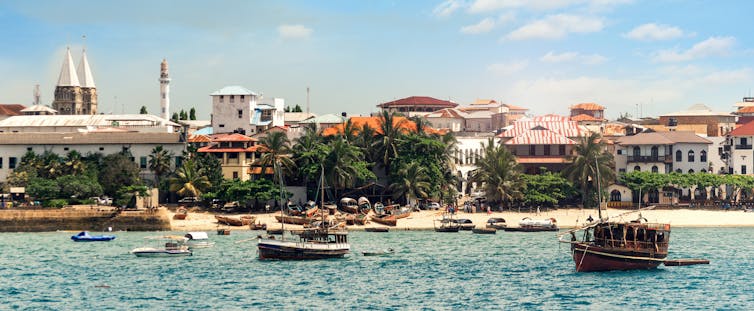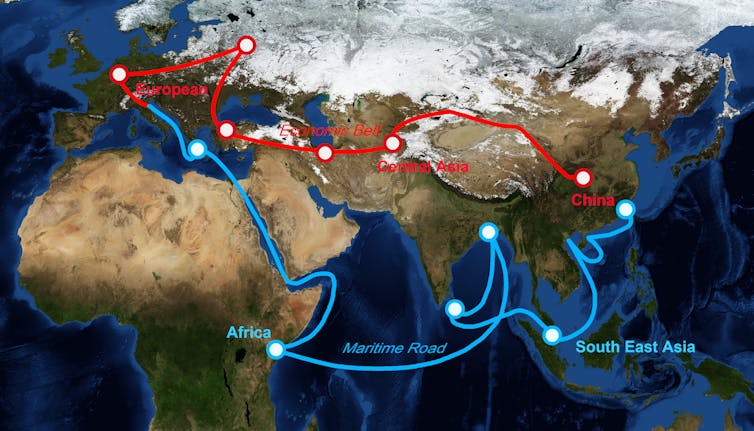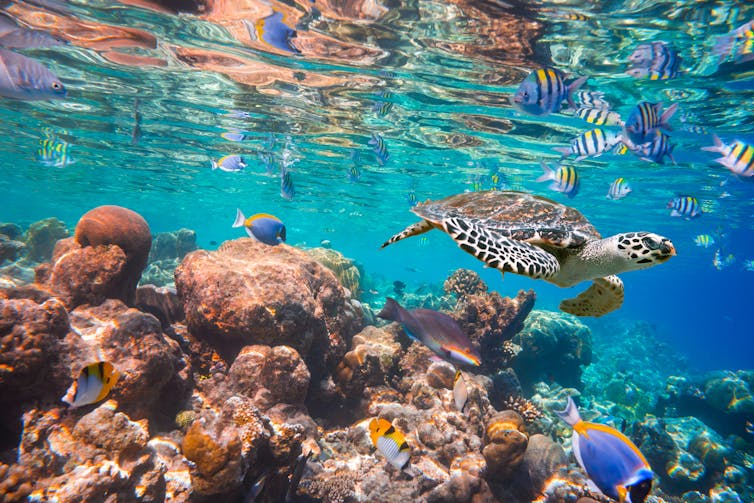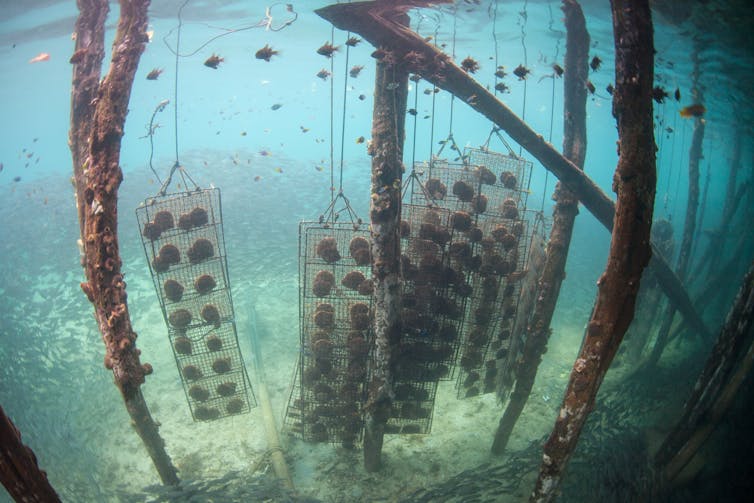On many beaches around the Indian Ocean, keen observers may spot bits of broken pottery. Washed smooth by the ocean, these shards are in all likelihood hundreds of years old, from centres of ceramic production like the Middle Eastern Abbasid caliphate and the Chinese Ming dynasty.
Originally destined for Indian Ocean port cities, this pottery would have been purchased by merchant elites accustomed to eating off fine plates. These traders formed part of vast commercial networks that crisscrossed the Indian Ocean arena and beyond, from East Africa to Indonesia, the Middle East and China.
These trade networks stretched back thousands of years, powered by the monsoon winds. Reversing direction in different seasons, these winds have long shaped the rhythm of life around the ocean, bringing rain to farmers, filling the sails of dhows and enabling trade between different ecological zones.

This story is part of Oceans 21
Five profiles open our series on the global ocean, delving into ancient Indian Ocean trade networks, Pacific plastic pollution, Arctic light and life, Atlantic fisheries and the Southern Ocean’s impact on global climate. Look out for new articles in the lead up to COP26. Brought to you by The Conversation’s international network.
The monsoon wind pattern makes the Indian Ocean relatively easy to cross both ways. In the Atlantic, by contrast, winds blow in one direction all year round. That’s why the Indian Ocean is the world’s oldest long-distance trans-oceanic trading arena, and is sometimes known as the cradle of globalisation.
This cosmopolitan world has long fascinated scholars and has become a vibrant domain of research. Yet this work has had little to say about the sea itself. Its focus is on human movement with the ocean as a passive backdrop. In the age of rising sea levels and climate change, it’s important to learn more about the sea from a material and ecological point of view.
Over the past few years, this situation has started to shift. In this article we survey both the older and the newer forms of Indian Ocean studies, of surface and depth.
Surface histories of the Indian Ocean
Given the long millennia of trade and exchange, one key concern of Indian Ocean studies has been a focus on cultural interaction. Cities on the shores have sustained deep forms of material, intellectual and cultural exchange, so that the denizens of these ports had more in common with each other than with their fellows inland.
This early cosmopolitan world has famously been explored in Amitav Ghosh’s In an Antique Land, which traces the travels of Abram bin Yiju, a 12th century Jewish Tunisian merchant based in Cairo and later in Mangalore, India. The book contrasts the rigidity of borders in the 1980s with the relative ease of movement in the late medieval Indian Ocean.
The Swahili coast provides another famed example of Indian Ocean cosmopolitanism. Stretching a thousand miles from Somalia to Mozambique, Swahili society arose from centuries of interaction between Africa, the Middle East and Asia.
Centred on coastal city states like Kilwa, Zanzibar and Lamu, Swahili trade networks reached far inland to present day Zimbabwe and outward to Persia, India and China. After reaching their height from the 12th to the 15th centuries, these city states were eventually undone by the Portuguese, who arrived from the early 16th century, seeking to establish a monopoly of the spice trade.

Central to these histories of mobility and exchange in the Indian Ocean has been the spread of Islam across land and sea from the 7th century CE. By the 14th century, mercantile networks around the Indian Ocean were almost entirely in the hands of Muslim traders.
In their wake came scholars, theologians, pilgrims, clerks, legal pundits and Sufi divines. Together, these groups created a shared economic, spiritual and legal frameworks. Sufism, a mystical form of Islam is an important strand in the Indian Ocean histories, as is the centrifugal power of the Hajj pilgrimage to Mecca.
European Colonisation along the Indian Ocean
When the Portuguese rounded the Cape in the late 15th century, they entered what many have termed a Muslim Lake, dominated in the north by the Turkish Ottoman, Persian Safavid and Indian Mughal empires. When the Dutch arrived in the Indian Ocean in the 17th century, “they were able to go from one end of it to another by carrying letters of introduction from Muslim sultans on various shores”.
As Engseng Ho has indicated, these sprawling networks of Muslim commerce operated without the backing of an army or a state.
The Portuguese, Dutch and English in the Indian Ocean were strange new traders who brought their states with them. They created militarised trading-post empires in the Indian Ocean, following Venetian and Genoese precedents in the Mediterranean, and were wont to do business at the point of a gun.
Early European entrants to the Indian Ocean world initially had to adapt to the trading orders that they encountered. But by the 19th century, European empires dominated. Their military, transport and communication infrastructure intensified the movement of people across the Indian Ocean world.
As Clare Anderson has demonstrated, much of this mobility was forced and conscripted. It involved slaves, indentured labourers, political exiles and prisoners who were transported between regions. At times, these systems built on existing foundations of labour exploitation. As recent research indicates, South Asian indentured labour was often taken from regions in India where slavery existed. Old and new systems of unfree labour produced an archipelago of prisons, plantations and penal colonies.
As an archive, the Indian Ocean provides a new way of looking at world history, that has previously been dominated by European accounts. The age of European empires is only one tiny sliver of time in a much longer arc. A view from the Indian Ocean unsettles ideas of the relationship between European colonisers and colonised groups.
As historians like Engseng Ho and Sugata Bose have argued, the Indian Ocean world was an arena of competing claims.
The ambitions of British imperialism, for example, were countered by the equally grand visions of Islam. Indeed, the Indian Ocean arena produced a rich repertoire of transoceanic ideologies, including Hindu reformism and pan-Buddhism.
Such ideologies eventually acquired an anti-imperial character which also fed into ideas of Afro-Asian solidarity and non-alignment. These arose from the Bandung Conference in 1955 at which 29 newly independent nations gathered to forge a new path rather than falling in line with either of the rival camps in the emerging Cold War.

In the 21st century, these older alliances have come under pressure as China and India elbow each other for dominance in the Indian Ocean. China’s ambitious Belt and Road Initiative involves massive transport and port infrastructure and aims to extend China’s footprint across much of the Indian Ocean arena. In response, New Delhi has bolstered its economic and military activity in this domain.
Deep histories of the Indian Ocean
While the uniquely well-travelled surface of the Indian Ocean has received much attention, its depths barely register in the cultural or historical imagination. Its waters constitute nearly 20% of the ocean’s total volume, and its deepest point, the Sunda Deep of the Java Trench, lies nearly 8km below the surface. Yet its seafloor, like much of the world’s oceans, is largely unmapped.
Seafloor features determine weather patterns, fish concentrations and tsunami dynamics. Initial explorations by mining companies revealed mineral-rich deposits on submarine volcanic vents, while new species are continually being discovered.
Read more: How many undiscovered creatures are there in the ocean?
The deep Indian Ocean is far less studied than the depths of the other oceans, for economic reasons: it is ringed by underdeveloped countries. The second International Indian Ocean Expedition was launched only in 2015, fifty years after the first. It aims to increase understanding about the oceanographic and biological characteristics of this undersampled ocean, as well as the ways in which it is changing.

Paying attention to the submarine world is becoming increasingly important in a time of climate change prompted by human activities. The Indian Ocean is warming faster than any of the other oceans, holding more than 70% of all the heat absorbed by the upper ocean since 2003. Indian Ocean islands – the Maldives being a well-known example – are already being submerged by rising global sea levels.
Cyclone patterns are shifting further south and happening more often as a result of the ocean’s rising temperature. The monsoon, which underpinned the Indian Ocean’s shipping networks and the rainfall patterns on its coastlines, is losing its power and predictability.
Deities, spirits and ancestors
While the Indian Ocean’s depths are in many ways opaque, they are not unpopulated in people’s imaginations. The ocean bustles with water deities, djinns, mermaids and ancestral spirits – a mythical submarine world that reflects the cosmopolitanism of its land populations.
In southern Africa this mix is especially rich: Khoisan/ First Nation water sprites, Muslim djinns introduced by South East Asian slaves, African ancestors, one of whose domains is the ocean, and British imperial ideas about the romance of the sea.
These ideas encounter each other and turn bodies of water into rich sites of memory and history. They have been explored by the Oceanic Humanities for the Global South project. Work by Confidence Joseph, Oupa Sibeko, Mapule Mohulatsi and Ryan Poinasamy explores the literary and artistic imaginations of southern Africa’s creolised waters.
Afrofuturist science fiction is also turning to the deep Indian Ocean. Mohale Mashigo’s Floating Rugs is situated in a submarine community on South Africa’s east coast. Mia Couto’s stories from the Mozambican coastline have long paired myths of mermaids with marine biology. Yvonne Adhiambo Owuor’s novel The Dragonfly Sea links contemporary Afro-Asian networks to the undersea.
Deep sea mining
Some exploration of the deep ocean can seem science-fictional, but isn’t.
The International Seabed Authority, a branch of the United Nations in operation since 2001 and responsible for parcelling out potential marine mining areas, has granted contracts for mining exploration in the Indian Ocean. At the same time, researchers are discovering an astonishing number of new deep ocean species on the same sites.

The submarine world has long been plundered for riches. Histories of pearl diving in the Indian Ocean – as in a central scene of Jules Verne’s Twenty Thousand Leagues under the Sea – are continued in today’s illegal abalone trade. Poachers on the coast of South Africa don scuba gear to harvest abalone to trade with Asian markets, linking the undersea to Indian Ocean criminal underworlds, along the same lines as the ancient trade networks.
At times these networks are the source of treasure. On the Island of Mozambique, for instance, the shards of blue pottery that were traded around the Indian Ocean are one of the objects of the active treasure hunting trade today. While some of the treasures are sold by dealers in antiquities, others provide crucial evidence for maritime archaeological research. Recently, the Slave Wrecks Project has discovered slave shipwrecks that provide concrete symbols of the transatlantic slave trade and link it to histories of Indian Ocean slavery and indenture.
The old waterfronts of East African port cities like Mombasa, Zanzibar and Lamu are dominated by buildings with a pure white finish. This present-day architecture echoes a centuries-old tradition of building houses, mosques and tombs from white coral stone and dressed with lime plaster. Made from shells and corals that began their life under the sea, this luminous plaster made port cities visible from afar to incoming vessels.
The ocean’s submarine life and its human histories are always entangled. And now writers, artists and scholars are increasingly drawing attention to their connectedness.


